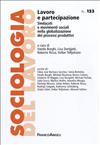
This article analyses the old and new dualisation processes that have emerged in Italy in the last twenty years. By focusing on the dualising outcomes of labour market and antipoverty policies, it addresses the trajectories followed by dualisa-tion and their effects on the divides between insiders and outsiders. Within this framework it is argued that dualisation is not a stable equilibrium, but rather the result of the interconnections between institutional arrangements and the variable decisions of social and political actors.








